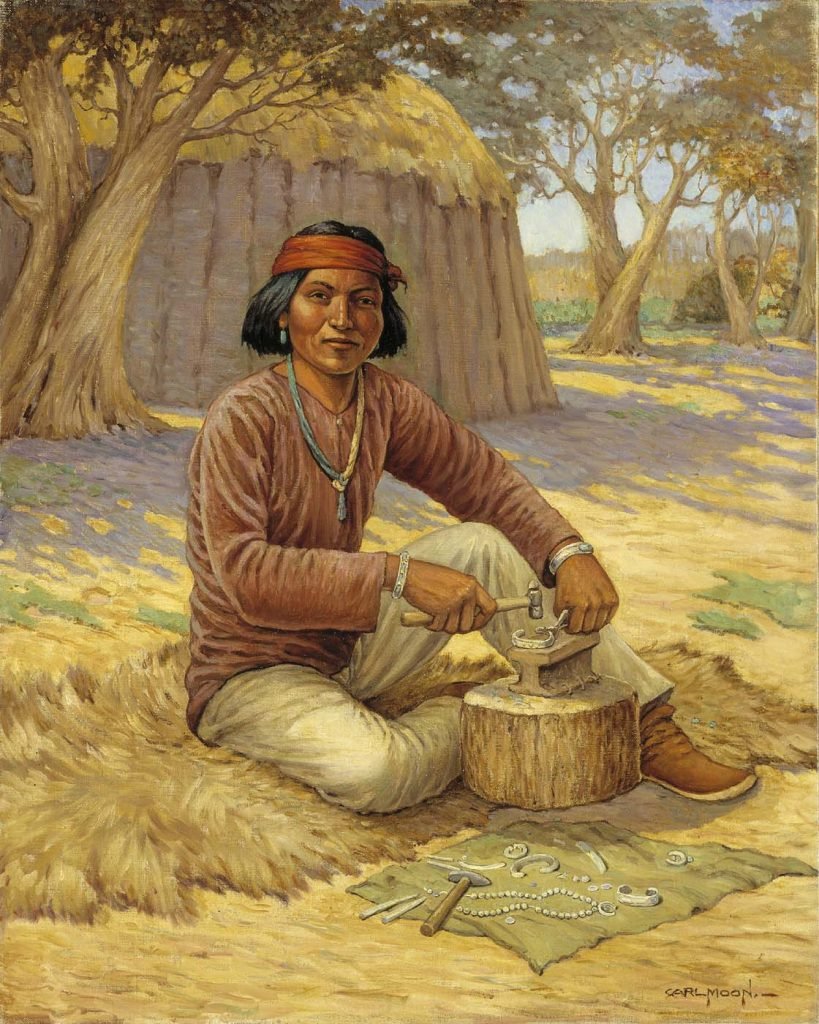Navajo Jewelry Making: A Confluence of Art, Culture, and Intertribal Exchange
Navajo jewelry making is a deeply rooted tradition that combines artistic expression, cultural identity, and centuries of intertribal exchange. Renowned for their intricate designs and exceptional craftsmanship, Navajo jewelers have long been celebrated for their contributions to Native American art and culture. This article will explore the history, techniques, and cultural significance of Navajo jewelry making, with particular emphasis on the ways in which interactions with other tribes and peoples have influenced the development and evolution of this unique art form.
Historical Development of Navajo Jewelry Making:
The Navajo people have been creating adornments and decorative objects for centuries, but their foray into metalworking and jewelry making is thought to have begun in the mid-19th century. Prior to this period, the Navajo primarily crafted items from materials such as shells, turquoise, and bone.
The introduction of metalworking to the Navajo can be traced to their interactions with Spanish and Mexican settlers, as well as other Native American tribes, particularly the Pueblo. From these encounters, the Navajo learned the techniques of silversmithing, which they quickly adapted and refined to create their own distinctive style of jewelry.
Early Navajo silversmiths primarily crafted utilitarian items such as bridles, buckles, and buttons, before expanding their repertoire to include ornamental pieces like bracelets, necklaces, and rings. The incorporation of turquoise, a highly prized material with deep spiritual significance in Navajo culture, further elevated the artistry and cultural importance of Navajo jewelry.
Key Historical Developments in Navajo Jewelry Making
Influence from Spanish, Mexican, and Pueblo peoples
Mid-19th century: Introduction of metalworking
Shift from utilitarian to ornamental pieces
Incorporation of turquoise
Techniques and Materials:
Navajo jewelry making is characterized by a blend of traditional and modern techniques, reflecting the tribe’s adaptability and artistic innovation. Early Navajo silversmiths used tools such as tongs, anvils, and hammers to shape silver, a process known as “forging.” They also employed a technique called “tufa casting,” which involves pouring molten metal into a mold made from tufa stone to create intricate designs.
Over time, Navajo jewelers have incorporated additional techniques, such as stamping, repoussé, and inlay work, into their repertoire. In particular, the use of inlay – a process in which small pieces of turquoise, coral, or other materials are set into the surface of the metal – has become a hallmark of Navajo jewelry.
In addition to silver and turquoise, Navajo jewelers frequently work with materials such as copper, brass, and a variety of semi-precious stones. These materials not only add visual interest and diversity to Navajo jewelry but also reflect the tribe’s deep connection to the natural world and their commitment to preserving traditional knowledge and techniques.
Navajo Jewelry Making Techniques and Materials
Forging
Tufa casting
Stamping, repoussé, and inlay work
Silver, turquoise, copper, brass, and semi-precious stones
The evolution of Navajo jewelry making has been significantly influenced by the tribe’s interactions with other Native American peoples and cultures. As previously mentioned, the introduction of metalworking to the Navajo can be traced back to their encounters with Spanish, Mexican, and Pueblo peoples. In addition to sharing technical knowledge and skills, these exchanges facilitated the incorporation of new materials and designs into Navajo jewelry.
The Zuni, another Southwestern tribe with a rich jewelry-making tradition, have also had a profound impact on the development of Navajo jewelry. The Zuni are particularly known for their intricate inlay work and use of materials such as coral and shell, which have been adopted and adapted by Navajo jewelers. Moreover, the Navajo have maintained trade relationships with tribes such as the Hopi and Apache, further fostering the exchange of artistic ideas, techniques, and materials.
Navajo Silversmith by Carl Moon

Contemporary Navajo Jewelry Making:
In the contemporary era, Navajo jewelry making continues to thrive and evolve, with artists drawing upon both traditional and modern influences to create innovative and visually stunning pieces. Today, Navajo jewelers work with a diverse array of materials, incorporating elements such as gold and diamonds alongside more traditional materials like turquoise and silver. Additionally, many contemporary Navajo artists have experimented with nontraditional techniques and forms, pushing the boundaries of what is considered “traditional” Navajo jewelry.
Despite these innovations, the core values of Navajo jewelry making – including an emphasis on craftsmanship, respect for cultural heritage, and connection to the natural world – remain central to the practice. Contemporary Navajo jewelers continue to draw inspiration from the rich history and cultural significance of their art, ensuring that the tradition remains vibrant and relevant for future generations.
Conclusion:
Navajo jewelry making is a remarkable art form that has been shaped by centuries of cultural exchange, adaptation, and innovation. From its beginnings as a utilitarian craft to its current status as a celebrated and distinctive art form, Navajo jewelry reflects the tribe’s resilience, creativity, and commitment to preserving their cultural heritage.
Through interactions with other tribes and peoples, the Navajo have continually expanded and refined their jewelry-making techniques, incorporating new materials and designs into their work. As a result, Navajo jewelry is not only a testament to the tribe’s artistic prowess but also a powerful symbol of the interconnected histories, cultures, and experiences of Native American peoples.
Sources Consulted:
- Adair, John. “The Navajo and Pueblo Silversmiths.” University of Oklahoma Press, 1989.
- Baxter, Paula A. “Encyclopedia of Native American Jewelry: A Guide to History, People, and Terms.” Greenwood Publishing Group, 2000.
- Frank, Larry, and Millard J. Holbrook II. “Indian Silver Jewelry of the Southwest, 1868-1930.” Schiffer Publishing, 1990.
- Schaaf, Gregory. “American Indian Jewelry I: 1200 Artist Biographies.” CIAC Press, 2003.
- Wright, Barton. “Hallmarks of the Southwest.” Schiffer Publishing, 2000.

